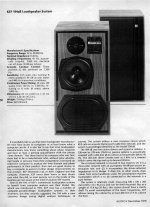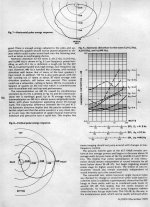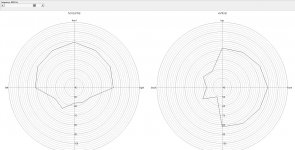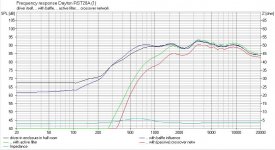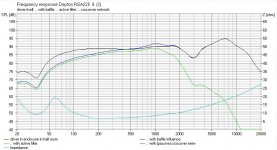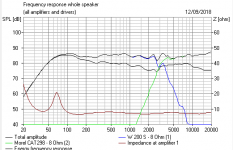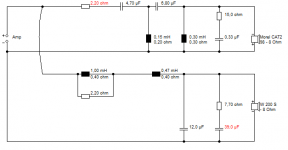KEF 104aB rebuild with MiniDSP and Dayton drivers
In 2011 I rebuilt a very old pair of KEF104 into KEF104ab using premium coils and caps (see my old post KEF 104 to KEF 104aB mkII with SPICE ). The crossover was rebuilt with Mundoff and Jentzen parts. I done a lot of careful tuning by listening. I did not have the facilities or equipment to do any measurements. The premium passive parts did not give a quantum leap from the original KEF104 crossover, but the HF are more comfortable. The pair of upgraded KEF 104ab served as a good nice living room speakers for many years. Things were not too demanding, the speakers were great for easy listening. The very same pair of KEF 104ab are still serving me well today.
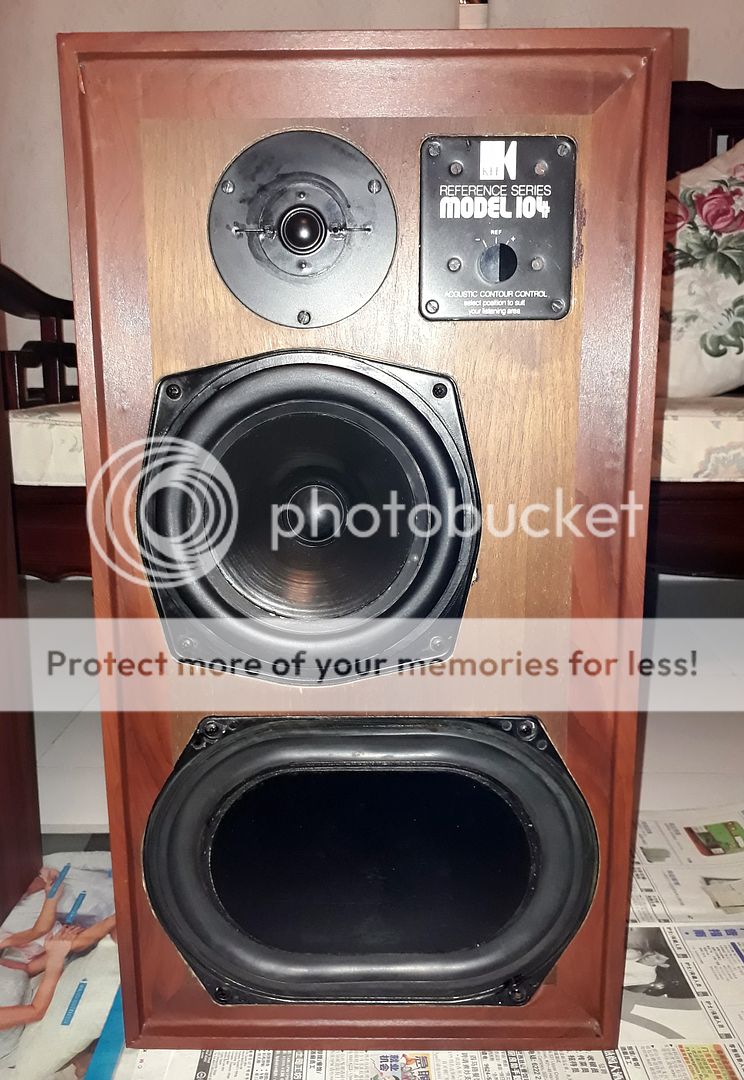
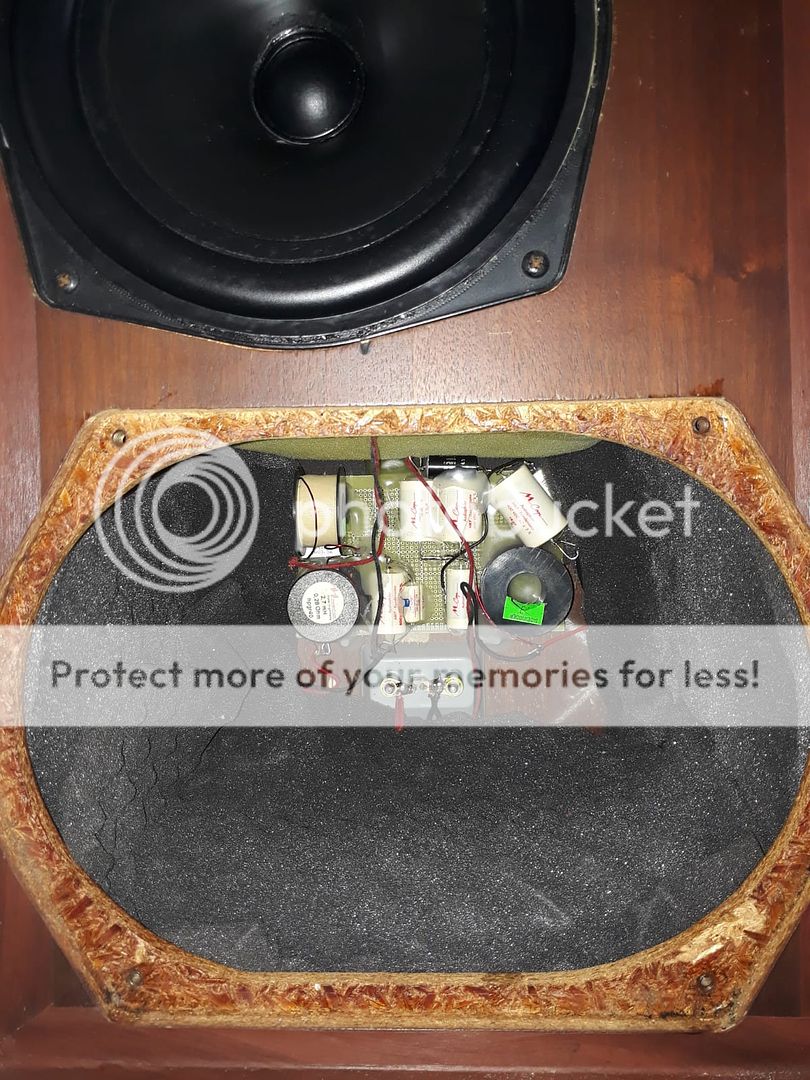
In 2012, I walked passed a shop in Singapore and saw a very old pair of KEF 104ab on display. The seller asked for US$500 for the pair. I had a listen and thought there were something wrong with the sound. I left the shop without any deal. Two years later in 2013, I saw the same pair of KEF 104ab still sitting in the shop. This time, the seller asked for US$200. Just for parts and repair. I examine the speakers and thought it was a fair deal. I brought the speakers home. Sadly, I later found that one of the KEF T27 was not working well ( the coil was burned and repaired by adding a thin wire). One of the cabinets was apparently damaged by moisture or partially soaked in water. I dismantled the drivers completely and checked the damage. Only one of the T27 was bad. The cross overs, B200 SP1039 pair, and the B139 SP1024 were in pretty good shape. While removing the drivers, part of the chip wood came off with drivers. It was really bad.
I later picked up a pair of new old stock KEF T27 from England, and also a pair of used B200 to rebuild the KEF 104ab. Due to work commitments, I did not have time and had to shelf the project. I done some cabinet repair, but then I stopped the project. I even forgotten I had the pair sitting in the store room for a good number of years.
THE CABINET
This year 2018 things have gotten better for me and I have more spare time. I dug up the old KEF 104ab cabinet from my store room and decided to work on it. What I have done a good many years ago remain. The cabinet has got rid of all the moisture that nearly destroyed it.

The chip wood near the recess for T27 and B200 was in terrible shape. Some of the portions simply turned into power and I had to rework with high quality wood putty, with a lot of sanding down and checking accuracy; and repeated severals. The most painful part of this restoration was the cabinet. The chip board are just bad! I did not want to rebuild with new wood, as the cabinet is afterall from 1975, it carries a lot of history with it.


With the help from a carpenter friend, I had the cabinet squared, sanded down, painted with wood glue and paint. The plan was to rebuild the speakers like the old KEF Kit 104ab with black face.

I applied two layers of wood coat and also sprayed painted the interior to prevent moisture attack. The original bitumen paddings were also fixed with wood glue. The cabinets finally have a new set of real wood veneer professionally applied. I planned to have the crossover reworked, drivers check and setup the speakers for the option of active crossover. I even had a 3khz BW active crossover built.


Active crossover using op amps with gain adjustment. This was set at LW4 setting.

When everything was in place, I found that after years of storage the KEF B200 curtains disintegrated! It took me months to look for spare curtains and someone to repair the cones professionally. I was supplied with wrong curtains from an American seller, and they refused to take returns. Finally, I found an Ebay seller in China who could supply the curtains. (OD 197mm, 185mm-142mm for the curved up area, and 125mm dia to cover the cone edge). I have no way to determine if the compliance of the rubber skirt matches the original KEF spec. The original KEF curtains are thinner and softer by feel.

The repaired KEF B200 SP1039 did not meet my expectations. Only 1 out of the 6 drivers may work well by listening, and the rest have different problems. It is very difficult to find used B200 in 2018, as compared to 2011 period. This ran into a deadlock.
Simulation using *Vistaon/Monacor drivers to emulate KEF B200
I later looked for replacement drivers like Visaton 8 in, Monacor SPM225, and the Peerless classic 8in. From the graphs, they all have their own characteristics, and may not match the B200 SP1039. I even ran several Visaton Boxsim simulations to emulate the B200 with these drivers. I was guessing all the time with no confirmation of results. I have to buy the drivers to confirm the results. The simulated curve was all over the place.

The B200 has a hefty magnet and is capable of fairly high music power handling. The problematic part is it has a Pincushioned cutout that many modern drivers do not adopt. And those which has a Pincushioned footprint does not match the B200, those are mostly replacement speakers for old TV. I ran into a big problem. I am not going to have my project to wait for a good pair of B200 to appear. ( Falcon may introduce the new B200 , maybe in 2019).
Finally, I decided to use a modern 8in driver to replace the B200. After much considerations, I decided to use the Dayton RS225P. Wait a minute, that is American, paper cone and very different animal from the B200. The Qt for the RS225P is low at 0.34. This maybe the most important parameter to look at, because the KEF 104ab has a big ABR the B139.
I have no idea how the B200 extends in the frequency range from 1khz. Many 8 inch cones show break ups at 3khz anyway.
The Dayton RS225P has a cut out of 184mm. It should be able to fit into the KEF cabinet in place of the B200.
I have read a lot of good reviews of the Dayton RS225 (alu cone) with the old RS28 tweeter. I later heard a pair of Dayton DIY using Mark K’s crossover and was very impressed. The passive components cost more than drivers itself. This is no longer the KEF 3rd order Butterworth design. The crossover have to cater for the Dayton characteristics and cut off rapidly at near 1.5khz both sides. The simulation using Boxsim (with Dayton’s FR and phase data) looks terrible (but the speaker sounded ok from the DIY pair I heard, it even had cut corner crossover)

(Mark K’s Design using elaborate passive components)
Dayton introduce the new RS225P and RST28A with better specifications. From my impression of the RS225+RS28, I decided to go the Active route with modern drivers. Afterall, the KEF T27 and B200 are already 45 years old!
For Boxsim, I put in every parameter as accurate as I could to use the Dayton RS225P and RST28A into the KEF 104 cabinet for simulation. The simulation took a long time for many iterations, and I was not happy with the results. Finally, I decided to go active.
The following compares the Active option simulation VS Passive Circuit response:

Active Two Amplfiers - 18db/Oct and some driver compensation.

Massive Passive Components
The Active approach has a more flat and easy to manage impedance change. The passive components has a challenge of Impedance drop to below 3 ohms level if not careful. Active also means less demand on the amplifier.
To take in the Dayton 8 in, it was back to the rework of the cabinet again! With wood putty, I was able to make a cutout suitable for any modern 8 in drivers that uses a ~190mm cut out. This took another month, and not to damage the already done wood veneer. I hated this part of the project 🙁 .


Finally, I decided to make the new KEF looks like something special. Nostalgic with 1970s feel, but with a modern standard in performance.
After weekss of struggling, the cabinet was ready. I polished the front face and resprayed the front with creamy yellow, to give it a nostalgic feel. The amount of putty, sanding and reiterations was painful. The cut out for the tweeter has to be reworked to house the RST28A. Due to the very bad condition of the front cabinet section , I had to put in wood brace to back the speaker anchoring locations behind the drivers.

The speaker was restuffed with sponge as per the original stuffing. The same type of sponge stuffing was used in old Tangent speakers. Everything was all set.

FINAL DRIVE!
Dayton RS225P and Dayton RST28A
There are already a lot of discussion on the two Dayton drivers in the Parts Express site, so I will not go into too much details. Basically, the RS225P exhibits break ups at 3khz and beyond, and have a dip at around 1khz. The Dayton spec looks rather similar to the SP1039, vaguely.
The RST28A has a low resonance at 775hz and response starts to drop after 15khz like the T27. The response is good, except a dip at 2khz. The T27 boast a response to beyond 20khz, but it struggles to go below 2khz.
The new combination RS225P and RST28A will have to be crossed at around or below 2khz, and whether to use BW or LR can only be decided after measurements.


MiniDSP Workflow
The internet is packed with much information on how to do a two way speaker crossover design using MiniDSP. Many are confusing. I also cannot understand how people design a crossover without understanding the behaviour of individual drivers, and not done any simulation.
Here is the workflow I followed:
Decide on the Tweeter and Woofer - they should have fairly flat frequency responses
Obtain the specification, graphs, ZMA/FRD information
Run simulations using Boxsim or other Simulation to understand how the drivers behave:
Any compensation needed to address the peaks/dips
How the impedance drop or rise in the working band ( less than 4 ohms is bad)
The optimal crossover frequency and type of filter (simpler is better)
4. Familiar with use of MiniDSP, Umik USB microphone and REW room measurement methods
5. Set up and calibrate the Microphone, computer and software, and understand measurement methods
6. Measure the response of the woofer:
Use DSP settings to shelf out the 3khz and above regions
Do not adjust the regions below 400hz as these could be room mode
7. Measure the response of the tweeter:
Introduce a deep notch at the Fr = 775hz to prevent resonance.
Smooth out the uneven response of the tweeter (add 2 db boost at 2khz dip)
8. Although the crossover is active, it does not mean there are no more passive components for the drivers. Put in Zobel to compensate the drivers. Put in at least 20-30uF to isolate the tweeter from the amplifier.




(This is NOT a crossover. It is the Zobel for both woofer and tweeter, and 30uf to isolate the tweeter. The old KEF Carlton III crossover board for illustration)
When the driver are linearized, then there is no need to use complex filter configuration to address the drivers. I found that the 3rd order Butterworth near 1.2khz for the tweeter, nearly 2 khz 2nd order Butterworth for the woofer may work. There is no need to replicate the complex steep attenuations done using passive components. (the cost of the coils + caps is more than the drivers and perhaps the MiniDSP 2/4 !)
Measurement done in a fairly big room with Umik 1 at 1m was encouraging.

The original KEF 104aB with passive components 3rd Order Butterworth crossover is within specifications. 50-20000khz +/-3dB:

The new KEF 104aB with Dayton drivers. I have done some adjustments on the tweeter. The 3rd order Butterworth filter works and integrate well. It looks more consistent than the KEF 104 drivers:

How does it sound?
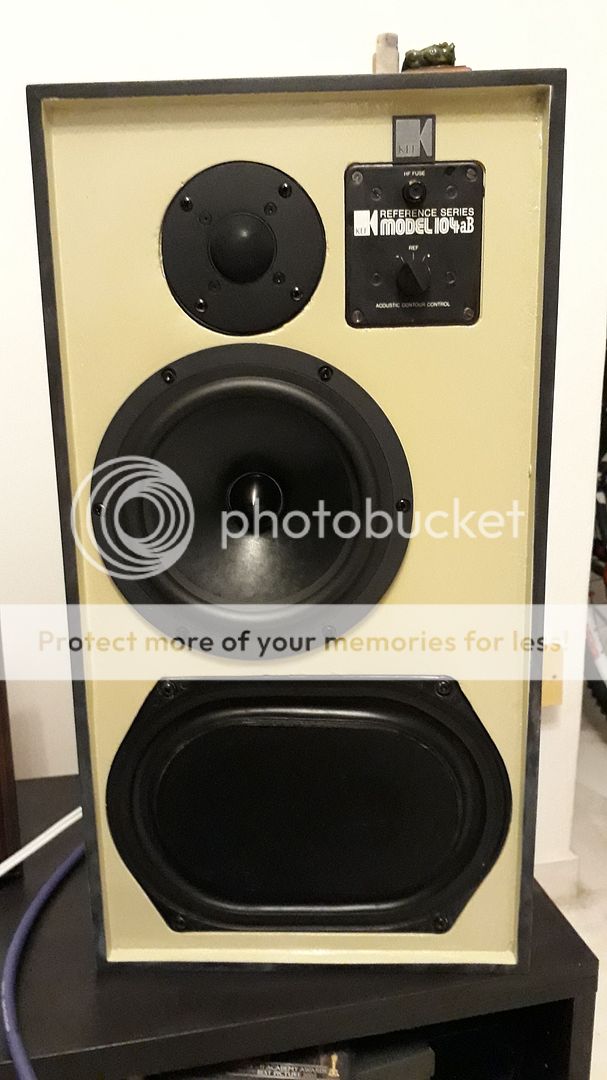
By measurement the ABR B139 worked with the RS225P with no issue. Bass was more tight and much better controlled. It does not deviate too much from the original KEF 104ab’s graph. But it does have a lot more details and the high frequency section is very comfortable. Now I can enjoy jazz music a lot more. The alu tweeters has an advantage when playing jazz.
2. I use two Pioneer A300 to bi amp the speakers. The settings are adjusted using Pink noise and measurement. The speaker sound very detailed, transparent and very modern. My next step will use the 4 X 100W Class D amplifier to drive the 4 drivers. This is another step to simplify the system. The MiniDSP can sit inside the same enclosure for the class D amp.
3. The original KEF 104ab sound more ‘bloated’ and have less control than the Dayton set. Also, there are not much musical details or timbre by comparison. (not bad for a 1970’s set still working!)
4. The speaker cabinet needs to be sturdy and strong, with proper damping
I am pleased that the final result is what I wanted. A speaker that looks nice, sounds great. The DSP Active crossover workflow is easier than passive components. It also eliminates the black art associated with the coils and caps design.

In 2011 I rebuilt a very old pair of KEF104 into KEF104ab using premium coils and caps (see my old post KEF 104 to KEF 104aB mkII with SPICE ). The crossover was rebuilt with Mundoff and Jentzen parts. I done a lot of careful tuning by listening. I did not have the facilities or equipment to do any measurements. The premium passive parts did not give a quantum leap from the original KEF104 crossover, but the HF are more comfortable. The pair of upgraded KEF 104ab served as a good nice living room speakers for many years. Things were not too demanding, the speakers were great for easy listening. The very same pair of KEF 104ab are still serving me well today.


In 2012, I walked passed a shop in Singapore and saw a very old pair of KEF 104ab on display. The seller asked for US$500 for the pair. I had a listen and thought there were something wrong with the sound. I left the shop without any deal. Two years later in 2013, I saw the same pair of KEF 104ab still sitting in the shop. This time, the seller asked for US$200. Just for parts and repair. I examine the speakers and thought it was a fair deal. I brought the speakers home. Sadly, I later found that one of the KEF T27 was not working well ( the coil was burned and repaired by adding a thin wire). One of the cabinets was apparently damaged by moisture or partially soaked in water. I dismantled the drivers completely and checked the damage. Only one of the T27 was bad. The cross overs, B200 SP1039 pair, and the B139 SP1024 were in pretty good shape. While removing the drivers, part of the chip wood came off with drivers. It was really bad.
I later picked up a pair of new old stock KEF T27 from England, and also a pair of used B200 to rebuild the KEF 104ab. Due to work commitments, I did not have time and had to shelf the project. I done some cabinet repair, but then I stopped the project. I even forgotten I had the pair sitting in the store room for a good number of years.
THE CABINET
This year 2018 things have gotten better for me and I have more spare time. I dug up the old KEF 104ab cabinet from my store room and decided to work on it. What I have done a good many years ago remain. The cabinet has got rid of all the moisture that nearly destroyed it.

The chip wood near the recess for T27 and B200 was in terrible shape. Some of the portions simply turned into power and I had to rework with high quality wood putty, with a lot of sanding down and checking accuracy; and repeated severals. The most painful part of this restoration was the cabinet. The chip board are just bad! I did not want to rebuild with new wood, as the cabinet is afterall from 1975, it carries a lot of history with it.


With the help from a carpenter friend, I had the cabinet squared, sanded down, painted with wood glue and paint. The plan was to rebuild the speakers like the old KEF Kit 104ab with black face.

I applied two layers of wood coat and also sprayed painted the interior to prevent moisture attack. The original bitumen paddings were also fixed with wood glue. The cabinets finally have a new set of real wood veneer professionally applied. I planned to have the crossover reworked, drivers check and setup the speakers for the option of active crossover. I even had a 3khz BW active crossover built.


Active crossover using op amps with gain adjustment. This was set at LW4 setting.

When everything was in place, I found that after years of storage the KEF B200 curtains disintegrated! It took me months to look for spare curtains and someone to repair the cones professionally. I was supplied with wrong curtains from an American seller, and they refused to take returns. Finally, I found an Ebay seller in China who could supply the curtains. (OD 197mm, 185mm-142mm for the curved up area, and 125mm dia to cover the cone edge). I have no way to determine if the compliance of the rubber skirt matches the original KEF spec. The original KEF curtains are thinner and softer by feel.

The repaired KEF B200 SP1039 did not meet my expectations. Only 1 out of the 6 drivers may work well by listening, and the rest have different problems. It is very difficult to find used B200 in 2018, as compared to 2011 period. This ran into a deadlock.
Simulation using *Vistaon/Monacor drivers to emulate KEF B200
I later looked for replacement drivers like Visaton 8 in, Monacor SPM225, and the Peerless classic 8in. From the graphs, they all have their own characteristics, and may not match the B200 SP1039. I even ran several Visaton Boxsim simulations to emulate the B200 with these drivers. I was guessing all the time with no confirmation of results. I have to buy the drivers to confirm the results. The simulated curve was all over the place.

The B200 has a hefty magnet and is capable of fairly high music power handling. The problematic part is it has a Pincushioned cutout that many modern drivers do not adopt. And those which has a Pincushioned footprint does not match the B200, those are mostly replacement speakers for old TV. I ran into a big problem. I am not going to have my project to wait for a good pair of B200 to appear. ( Falcon may introduce the new B200 , maybe in 2019).
Finally, I decided to use a modern 8in driver to replace the B200. After much considerations, I decided to use the Dayton RS225P. Wait a minute, that is American, paper cone and very different animal from the B200. The Qt for the RS225P is low at 0.34. This maybe the most important parameter to look at, because the KEF 104ab has a big ABR the B139.
I have no idea how the B200 extends in the frequency range from 1khz. Many 8 inch cones show break ups at 3khz anyway.
The Dayton RS225P has a cut out of 184mm. It should be able to fit into the KEF cabinet in place of the B200.
I have read a lot of good reviews of the Dayton RS225 (alu cone) with the old RS28 tweeter. I later heard a pair of Dayton DIY using Mark K’s crossover and was very impressed. The passive components cost more than drivers itself. This is no longer the KEF 3rd order Butterworth design. The crossover have to cater for the Dayton characteristics and cut off rapidly at near 1.5khz both sides. The simulation using Boxsim (with Dayton’s FR and phase data) looks terrible (but the speaker sounded ok from the DIY pair I heard, it even had cut corner crossover)

(Mark K’s Design using elaborate passive components)
Dayton introduce the new RS225P and RST28A with better specifications. From my impression of the RS225+RS28, I decided to go the Active route with modern drivers. Afterall, the KEF T27 and B200 are already 45 years old!
For Boxsim, I put in every parameter as accurate as I could to use the Dayton RS225P and RST28A into the KEF 104 cabinet for simulation. The simulation took a long time for many iterations, and I was not happy with the results. Finally, I decided to go active.
The following compares the Active option simulation VS Passive Circuit response:

Active Two Amplfiers - 18db/Oct and some driver compensation.

Massive Passive Components
The Active approach has a more flat and easy to manage impedance change. The passive components has a challenge of Impedance drop to below 3 ohms level if not careful. Active also means less demand on the amplifier.
To take in the Dayton 8 in, it was back to the rework of the cabinet again! With wood putty, I was able to make a cutout suitable for any modern 8 in drivers that uses a ~190mm cut out. This took another month, and not to damage the already done wood veneer. I hated this part of the project 🙁 .


Finally, I decided to make the new KEF looks like something special. Nostalgic with 1970s feel, but with a modern standard in performance.
After weekss of struggling, the cabinet was ready. I polished the front face and resprayed the front with creamy yellow, to give it a nostalgic feel. The amount of putty, sanding and reiterations was painful. The cut out for the tweeter has to be reworked to house the RST28A. Due to the very bad condition of the front cabinet section , I had to put in wood brace to back the speaker anchoring locations behind the drivers.

The speaker was restuffed with sponge as per the original stuffing. The same type of sponge stuffing was used in old Tangent speakers. Everything was all set.

FINAL DRIVE!
Dayton RS225P and Dayton RST28A
There are already a lot of discussion on the two Dayton drivers in the Parts Express site, so I will not go into too much details. Basically, the RS225P exhibits break ups at 3khz and beyond, and have a dip at around 1khz. The Dayton spec looks rather similar to the SP1039, vaguely.
The RST28A has a low resonance at 775hz and response starts to drop after 15khz like the T27. The response is good, except a dip at 2khz. The T27 boast a response to beyond 20khz, but it struggles to go below 2khz.
The new combination RS225P and RST28A will have to be crossed at around or below 2khz, and whether to use BW or LR can only be decided after measurements.


MiniDSP Workflow
The internet is packed with much information on how to do a two way speaker crossover design using MiniDSP. Many are confusing. I also cannot understand how people design a crossover without understanding the behaviour of individual drivers, and not done any simulation.
Here is the workflow I followed:
Decide on the Tweeter and Woofer - they should have fairly flat frequency responses
Obtain the specification, graphs, ZMA/FRD information
Run simulations using Boxsim or other Simulation to understand how the drivers behave:
Any compensation needed to address the peaks/dips
How the impedance drop or rise in the working band ( less than 4 ohms is bad)
The optimal crossover frequency and type of filter (simpler is better)
4. Familiar with use of MiniDSP, Umik USB microphone and REW room measurement methods
5. Set up and calibrate the Microphone, computer and software, and understand measurement methods
6. Measure the response of the woofer:
Use DSP settings to shelf out the 3khz and above regions
Do not adjust the regions below 400hz as these could be room mode
7. Measure the response of the tweeter:
Introduce a deep notch at the Fr = 775hz to prevent resonance.
Smooth out the uneven response of the tweeter (add 2 db boost at 2khz dip)
8. Although the crossover is active, it does not mean there are no more passive components for the drivers. Put in Zobel to compensate the drivers. Put in at least 20-30uF to isolate the tweeter from the amplifier.




(This is NOT a crossover. It is the Zobel for both woofer and tweeter, and 30uf to isolate the tweeter. The old KEF Carlton III crossover board for illustration)
When the driver are linearized, then there is no need to use complex filter configuration to address the drivers. I found that the 3rd order Butterworth near 1.2khz for the tweeter, nearly 2 khz 2nd order Butterworth for the woofer may work. There is no need to replicate the complex steep attenuations done using passive components. (the cost of the coils + caps is more than the drivers and perhaps the MiniDSP 2/4 !)
Measurement done in a fairly big room with Umik 1 at 1m was encouraging.

The original KEF 104aB with passive components 3rd Order Butterworth crossover is within specifications. 50-20000khz +/-3dB:

The new KEF 104aB with Dayton drivers. I have done some adjustments on the tweeter. The 3rd order Butterworth filter works and integrate well. It looks more consistent than the KEF 104 drivers:

How does it sound?

By measurement the ABR B139 worked with the RS225P with no issue. Bass was more tight and much better controlled. It does not deviate too much from the original KEF 104ab’s graph. But it does have a lot more details and the high frequency section is very comfortable. Now I can enjoy jazz music a lot more. The alu tweeters has an advantage when playing jazz.
2. I use two Pioneer A300 to bi amp the speakers. The settings are adjusted using Pink noise and measurement. The speaker sound very detailed, transparent and very modern. My next step will use the 4 X 100W Class D amplifier to drive the 4 drivers. This is another step to simplify the system. The MiniDSP can sit inside the same enclosure for the class D amp.
3. The original KEF 104ab sound more ‘bloated’ and have less control than the Dayton set. Also, there are not much musical details or timbre by comparison. (not bad for a 1970’s set still working!)
4. The speaker cabinet needs to be sturdy and strong, with proper damping
I am pleased that the final result is what I wanted. A speaker that looks nice, sounds great. The DSP Active crossover workflow is easier than passive components. It also eliminates the black art associated with the coils and caps design.

Attachments
-
 Japan DSP.jpg62 KB · Views: 193
Japan DSP.jpg62 KB · Views: 193 -
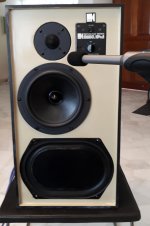 00A1.jpg370.9 KB · Views: 168
00A1.jpg370.9 KB · Views: 168 -
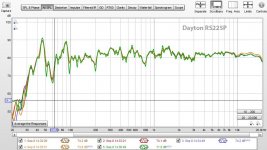 00A2.jpg298.4 KB · Views: 176
00A2.jpg298.4 KB · Views: 176 -
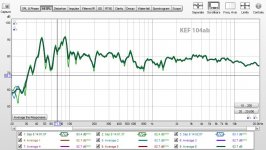 00A3.jpg268.6 KB · Views: 139
00A3.jpg268.6 KB · Views: 139 -
 00A4.jpg622.6 KB · Views: 207
00A4.jpg622.6 KB · Views: 207 -
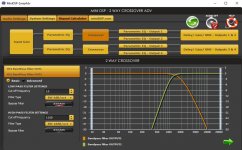 00A1a.JPG113.7 KB · Views: 118
00A1a.JPG113.7 KB · Views: 118 -
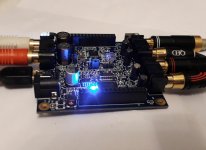 00A1b.jpg440.3 KB · Views: 154
00A1b.jpg440.3 KB · Views: 154 -
 IMG-20180830-WA0017.jpg195.2 KB · Views: 232
IMG-20180830-WA0017.jpg195.2 KB · Views: 232 -
 AAKEF-2.jpg625.4 KB · Views: 150
AAKEF-2.jpg625.4 KB · Views: 150 -
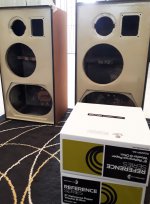 AAKEF-1b.jpg452.3 KB · Views: 139
AAKEF-1b.jpg452.3 KB · Views: 139
Last edited:
The Polar plots from simulation shows good and stable on axis and follows the 3rd order Butterworth Polar. Listening wise, the imaging is good and stable. Better imaging than original KEF.
100Hz
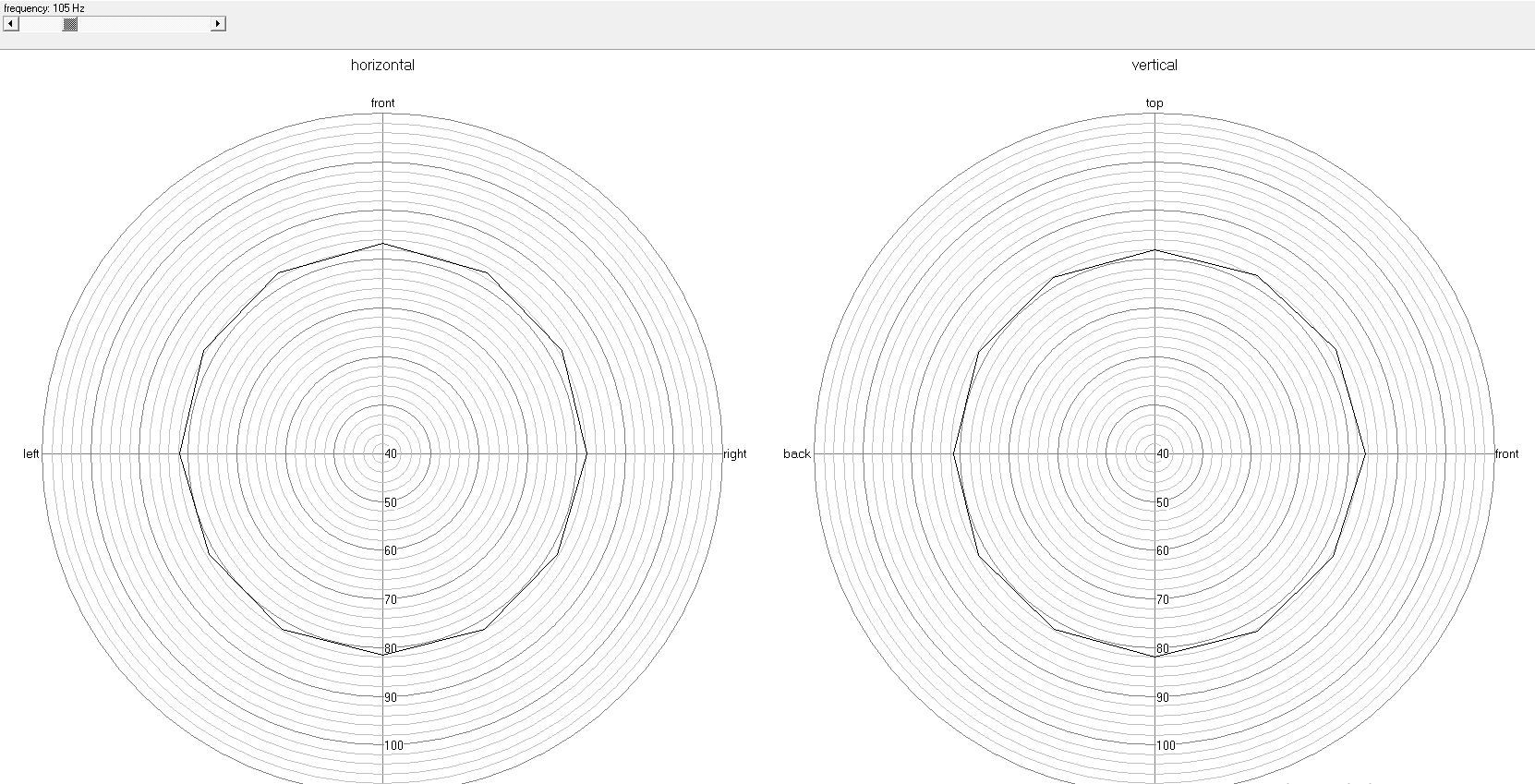
1 khz
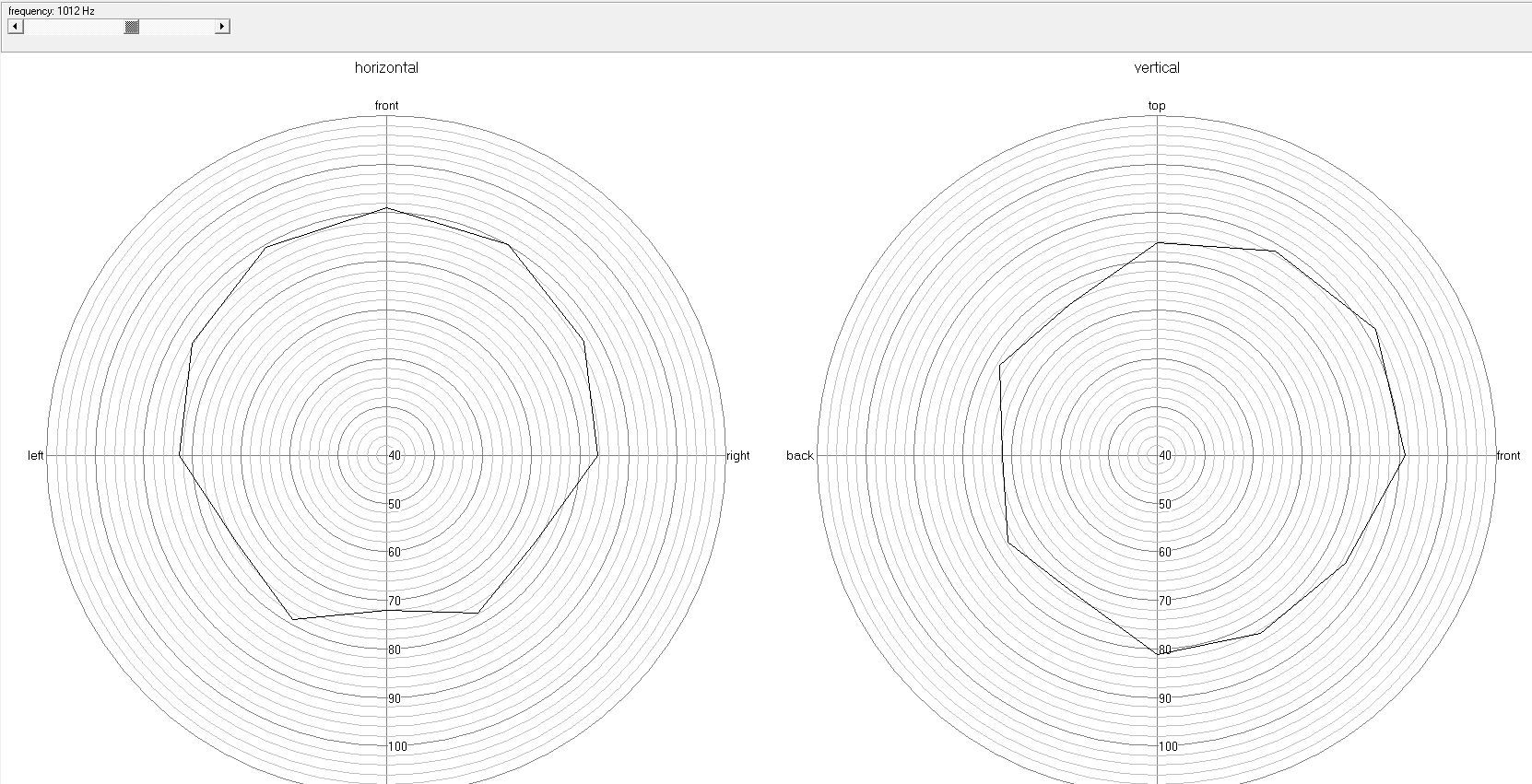
6 khz
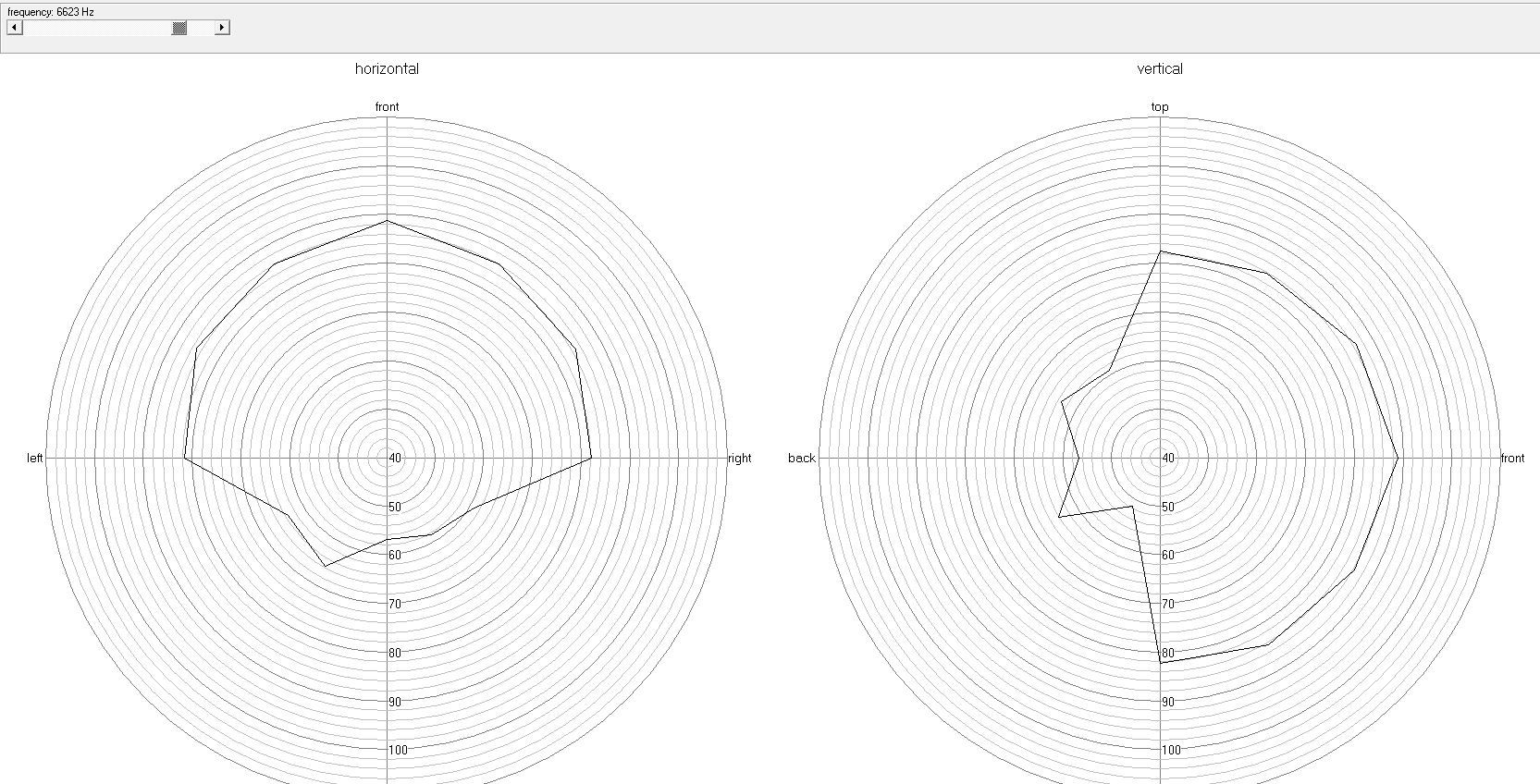
10 khz
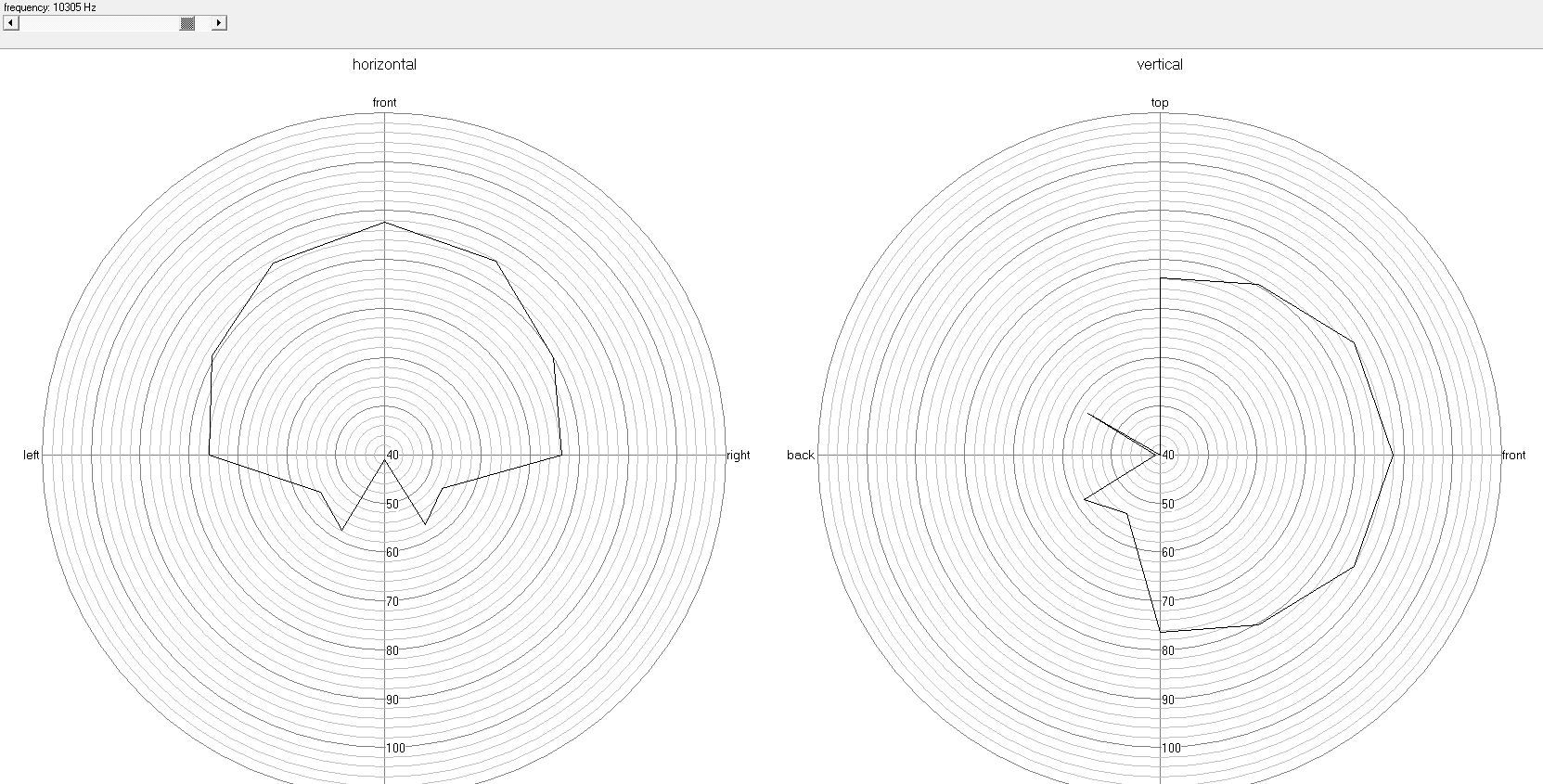
100Hz

1 khz

6 khz

10 khz

Last edited:
Sorry, what is the point of a Zobel in an active speaker? I'm not sure how this helps the FR at all. Someone please fill me in.
Sorry, what is the point of a Zobel in an active speaker? I'm not sure how this helps the FR at all. Someone please fill me in.
I was wondering that myself
Thanks guys. The Zobel is to compensate for the inductance in the speaker coil. It does not do much for the FR but it helps in the impedance of the driver. Makes it an easier load for the amplifier.
Hmm, well I've got to admire the effort that went into that, but I really don't think that was a good or useful homage to the BBC tradition in drivers or crossover.
All been done before, of course. You will find most everything about this BBC style in the polycone Rogers LS5/9: Rogers Loudspeakers › LS5/9
The passive filter was so good that it rendered the original above average BBC active filter redundant. Details of that active crossover in the quoted BBC paper. The big Audax tweeter might as well have been a 25mm jobbie with the highish 3kHz negative polarity crossover.
The tradition is still alive and well and sounding good at Harbeth using a newer 8" bass and SEAS 1" metal dome in the M30.2: Harbeth 30.2 Anniversary Loudspeakers Review & Test | Hi-Fi | Review | AVHub
Modern drivers have got to be largely better than those early polypropylene cones, so I'm still interested in the classic BW3 two way monitor. My favourite speakers I build always have a lot of BBC DNA in them:
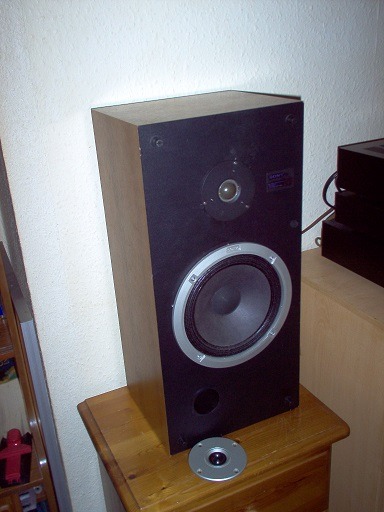
Mind you, if you don't listen to Classic FM, you won't know why it matters. This style can be very good indeed. 🙂
All been done before, of course. You will find most everything about this BBC style in the polycone Rogers LS5/9: Rogers Loudspeakers › LS5/9
The passive filter was so good that it rendered the original above average BBC active filter redundant. Details of that active crossover in the quoted BBC paper. The big Audax tweeter might as well have been a 25mm jobbie with the highish 3kHz negative polarity crossover.
The tradition is still alive and well and sounding good at Harbeth using a newer 8" bass and SEAS 1" metal dome in the M30.2: Harbeth 30.2 Anniversary Loudspeakers Review & Test | Hi-Fi | Review | AVHub
Modern drivers have got to be largely better than those early polypropylene cones, so I'm still interested in the classic BW3 two way monitor. My favourite speakers I build always have a lot of BBC DNA in them:
Mind you, if you don't listen to Classic FM, you won't know why it matters. This style can be very good indeed. 🙂
Thanks guys. The Zobel is to compensate for the inductance in the speaker coil. It does not do much for the FR but it helps in the impedance of the driver. Makes it an easier load for the amplifier.
ooooooook.
I'm stepping away from this. Too tired. Nice looking build.
This project is a homage to KEF 1970's spirit - innovation and using computer simulations to bring out the best system performance. This was one of the first speakers designed using computer simulations and calculations. KEF used the T27 and B200 which are active drivers, and a passive B139 which is a passive ABR. If not for the 6 deteriorated B200 I face, I might have shared with you a rebuild KEF104ab with a passive KEF crossover / 104ab derived opamp active crossover.
The high frequency cross over of the 104aB uses an asymptopic 18db/oct and it took into considerations of the driver impedance reflection into the design. It was not designed with the consideration of treating the T27 as a pure resistor load. It also use a notch at near the Fs of the T27 which I mentioned in my Psice simulation in 2011 rebuilt.
KEF 104ab offered 3 settings at (-) REF and (+). referring to the impedance load graph as published by Audio in 1979, there is a measured boost or dip at 2khz. This is not an issue for solid state amplifier but can be an issue for tube amplifier. The total impedance drop to below 6 ohms at 10khz. If the speaker wires are too thin (<22 guage) it will cause a peak rise near 1khz.
The 3khz region has serious phase alignment issue , it is 60 degrees lagging which can be seen in simulation. This can draw a lot of current demand from the amplifier at louder program. For modern amplifiers this may not be felt, but I suspect this could be a cause many T27 were fried twhen played loud (amplifier clip).
Low frequency impedance peak at 50hz to over 30hms. The complex reactance plot shows two peaks at 15hz and 55hz. The 15hz due to the ABR resonance is an issue with LP playback system (record warp) . This is seen in the simulation and a very low register attenuation was added to prevent the KEF subsonic boom.
In summary, the KEF104ab has flaws (rather a few, workmanship is definitely one of them). It needs thick speaker cables and a very good power amplifier to deliver. The results were already discussed in details by Richard C Heyser in 1979.
The Polar vertical and horizontal plots by Audio report shows the KEF 104ab has enough energy to cover a very wide region from the sides and upwards. I have lived with the KEF104ab and knows how it behaves. In the Boxsim simulation I have tried every effort to emulate the same wide vertical dispersion as well as the side 30 degrees dispersion as in the KEF. Refer the the Polar plots I shared. If the Butterworth 3rd is not used, the Polar dispersion will be dreadful near the cross over region.
As with regards to the Zobel, the effect on the FR can be seen on simulation curves to flatten it out like a ruler, otherwise it will rise from 8 to 15ohms in the working region for the RST225P. For the tweeter it may not be obvious but the final impedance is stabilized to near 5 ohms throughout the working region. The principle of neutralizing the inductance with the Zobels work rather well. Some speaker driver manufacturers recommends the use of Zobel. As I am going to use 4X 100W compact amplifier to driver the Dayton drivers, and playing it loud, the Zobel will surely help especially in transient regions. In view of the driver electrical characters like a motor, you still need a Zobel for an active system. I can do some transient measurements to show this.
Nobody from Parts Express nor this forum gave me a crossover design to use the Dayton drivers to duplicate the KEF 104ab performance. The settings in the MiniDSP use a lot of learning from the KEF crossover designs, Pspice and Boxsim simulations. The drivers FR are linearized in the parametric setting. The Cross over characteristics were plug in using using simulation results. If without the simulation, the parameter settings by iterations of measurements (BW3? LR2? LR4?) can be a never ending story.
The Dayton results in terms of FR is almost like the KEF 104ab which I showed (that is without Room EQ step). The Polar dispersion is about the same, given excellent imaging and wide sound stage horizontally and vertically. I am driving the speakers using 4X100W Class D with no obvious overloading or heat on the heat sinks. Technology is changing fast these days. This will pave the way for my KEF 105.4 clone project, which is in progress.
The high frequency cross over of the 104aB uses an asymptopic 18db/oct and it took into considerations of the driver impedance reflection into the design. It was not designed with the consideration of treating the T27 as a pure resistor load. It also use a notch at near the Fs of the T27 which I mentioned in my Psice simulation in 2011 rebuilt.
KEF 104ab offered 3 settings at (-) REF and (+). referring to the impedance load graph as published by Audio in 1979, there is a measured boost or dip at 2khz. This is not an issue for solid state amplifier but can be an issue for tube amplifier. The total impedance drop to below 6 ohms at 10khz. If the speaker wires are too thin (<22 guage) it will cause a peak rise near 1khz.
The 3khz region has serious phase alignment issue , it is 60 degrees lagging which can be seen in simulation. This can draw a lot of current demand from the amplifier at louder program. For modern amplifiers this may not be felt, but I suspect this could be a cause many T27 were fried twhen played loud (amplifier clip).
Low frequency impedance peak at 50hz to over 30hms. The complex reactance plot shows two peaks at 15hz and 55hz. The 15hz due to the ABR resonance is an issue with LP playback system (record warp) . This is seen in the simulation and a very low register attenuation was added to prevent the KEF subsonic boom.
In summary, the KEF104ab has flaws (rather a few, workmanship is definitely one of them). It needs thick speaker cables and a very good power amplifier to deliver. The results were already discussed in details by Richard C Heyser in 1979.
The Polar vertical and horizontal plots by Audio report shows the KEF 104ab has enough energy to cover a very wide region from the sides and upwards. I have lived with the KEF104ab and knows how it behaves. In the Boxsim simulation I have tried every effort to emulate the same wide vertical dispersion as well as the side 30 degrees dispersion as in the KEF. Refer the the Polar plots I shared. If the Butterworth 3rd is not used, the Polar dispersion will be dreadful near the cross over region.
As with regards to the Zobel, the effect on the FR can be seen on simulation curves to flatten it out like a ruler, otherwise it will rise from 8 to 15ohms in the working region for the RST225P. For the tweeter it may not be obvious but the final impedance is stabilized to near 5 ohms throughout the working region. The principle of neutralizing the inductance with the Zobels work rather well. Some speaker driver manufacturers recommends the use of Zobel. As I am going to use 4X 100W compact amplifier to driver the Dayton drivers, and playing it loud, the Zobel will surely help especially in transient regions. In view of the driver electrical characters like a motor, you still need a Zobel for an active system. I can do some transient measurements to show this.
Nobody from Parts Express nor this forum gave me a crossover design to use the Dayton drivers to duplicate the KEF 104ab performance. The settings in the MiniDSP use a lot of learning from the KEF crossover designs, Pspice and Boxsim simulations. The drivers FR are linearized in the parametric setting. The Cross over characteristics were plug in using using simulation results. If without the simulation, the parameter settings by iterations of measurements (BW3? LR2? LR4?) can be a never ending story.
The Dayton results in terms of FR is almost like the KEF 104ab which I showed (that is without Room EQ step). The Polar dispersion is about the same, given excellent imaging and wide sound stage horizontally and vertically. I am driving the speakers using 4X100W Class D with no obvious overloading or heat on the heat sinks. Technology is changing fast these days. This will pave the way for my KEF 105.4 clone project, which is in progress.
Attachments
Last edited:
nimo_jon, you are studiously avoiding the one person in this thread who actually understands what you are attempting to do. Me. 😱
First thing every creative artist knows is you never stop learning. Second thing is never listen to the plaudits from people who really don't get it.
TBH, and everybody knows this who worked with the old bextrene drivers, like Lynn Olson, is that they were rubbish. But that led to a lot of innovation in fixing them.
This is my current 8" paper bass plus 1" soft dome toy.
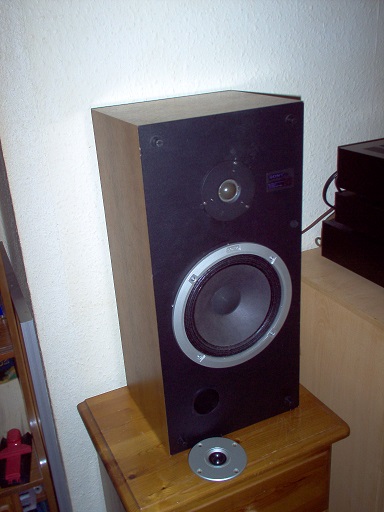
I am actually using a LR4 phase-aligned circuit on the tweeter. It's not quite the Rogers LS5/9 circuit, but close:
Rogers Loudspeakers › LS5/9
In fact, there isn't a huge difference between polycones and paper cones:
H1659-08 U22REX/P-SL
H1288-08 CA22RNX
And I really don't find much difference between an ABR and a reflex.
But, for sure, the key to the 8" plus 1" BBC sound is negative polarity at 3kHz crossover. LR4 is certainly low distortion, but BW3 works the magic IMO. Just lose the 0.3mH coil for BW3.
First thing every creative artist knows is you never stop learning. Second thing is never listen to the plaudits from people who really don't get it.
TBH, and everybody knows this who worked with the old bextrene drivers, like Lynn Olson, is that they were rubbish. But that led to a lot of innovation in fixing them.
This is my current 8" paper bass plus 1" soft dome toy.
I am actually using a LR4 phase-aligned circuit on the tweeter. It's not quite the Rogers LS5/9 circuit, but close:
Rogers Loudspeakers › LS5/9
In fact, there isn't a huge difference between polycones and paper cones:
H1659-08 U22REX/P-SL
H1288-08 CA22RNX
And I really don't find much difference between an ABR and a reflex.
But, for sure, the key to the 8" plus 1" BBC sound is negative polarity at 3kHz crossover. LR4 is certainly low distortion, but BW3 works the magic IMO. Just lose the 0.3mH coil for BW3.
Attachments
Hi Steve not avoiding you at all mate.
The KEF project is now into the fine tuning phase. Unlike passive cross over once done it is cast in stone. The Dayton 8 in RS225P and RST28A are slowly breaking in and the bass is now a lot better. I am sure if KEF had access to these drivers in the 70s they would had use them.
I had been to the KEF showroom to have a taste of their latest R series and also top of the line Blade. Just to train my ears to ensure I understand what is KEF giving today. KEF has come a long way using the UniQ drivers and also D'Appolito MTM. With so much competition coming from Germany and Norther European speaker drivers manufacturers, I find the Blade has done an excellent job. Perhaps due to the small demo room, I could not justify the asking price of the Blades. This brings to another point - room acoustics.
The KEF 104ab is already 45 years old. It is not fair to compare the 70s technologies with today's transducer/amplification standards. However, the use of DSP for driver cross over and equalization PLUS Room acoustics tuning give the KEF 104ab a new life.
Part 2 of this project is still on going: to tune the speakers using REW and Umic-1 and adjust to the room characteristics. I am now tweaking it, it is fun and amazing.
Room EQ Wizard (REW)
The KEF project is now into the fine tuning phase. Unlike passive cross over once done it is cast in stone. The Dayton 8 in RS225P and RST28A are slowly breaking in and the bass is now a lot better. I am sure if KEF had access to these drivers in the 70s they would had use them.
I had been to the KEF showroom to have a taste of their latest R series and also top of the line Blade. Just to train my ears to ensure I understand what is KEF giving today. KEF has come a long way using the UniQ drivers and also D'Appolito MTM. With so much competition coming from Germany and Norther European speaker drivers manufacturers, I find the Blade has done an excellent job. Perhaps due to the small demo room, I could not justify the asking price of the Blades. This brings to another point - room acoustics.
The KEF 104ab is already 45 years old. It is not fair to compare the 70s technologies with today's transducer/amplification standards. However, the use of DSP for driver cross over and equalization PLUS Room acoustics tuning give the KEF 104ab a new life.
Part 2 of this project is still on going: to tune the speakers using REW and Umic-1 and adjust to the room characteristics. I am now tweaking it, it is fun and amazing.
Room EQ Wizard (REW)
Last edited:
I need to mention I studied the Texas Instrument 2 way speaker active cross over application carefully. I have built the opamp cross over and time delay. Link to TI application note:
http://www.ti.com/lit/ug/tidu035/tidu035.pdf
Incidentally the project used the Dayton RS28F and RS180-8.
TI provides a software to calculate the Opamp active filter design FilterPro 3. Register an account with TI to download:
FILTERPRO WEBENCH Active Filter Designer | TI.com
My approach should had been to use MiniDSP to determine the crossover frequency, the time delay, and then build a fixed PCB circuit. The amount of tweaking using the MiniDSP may change from Music program to program.
As the original KEF104ab is pretty good reproducing Piano program, I use a lot of Piano (classical as well as Jazz) music to tune the Dayton upgrade. The Dayton may sound a little drier than the KEF, but it is a lot more accurate and involving.
http://www.ti.com/lit/ug/tidu035/tidu035.pdf
Incidentally the project used the Dayton RS28F and RS180-8.
TI provides a software to calculate the Opamp active filter design FilterPro 3. Register an account with TI to download:
FILTERPRO WEBENCH Active Filter Designer | TI.com
My approach should had been to use MiniDSP to determine the crossover frequency, the time delay, and then build a fixed PCB circuit. The amount of tweaking using the MiniDSP may change from Music program to program.
As the original KEF104ab is pretty good reproducing Piano program, I use a lot of Piano (classical as well as Jazz) music to tune the Dayton upgrade. The Dayton may sound a little drier than the KEF, but it is a lot more accurate and involving.
Some updates on the driver equalization and tuning:
Without using passive filters, the 3000hz cone break ups is addressed by parametric filters. Anything above 5000hz is shelved.
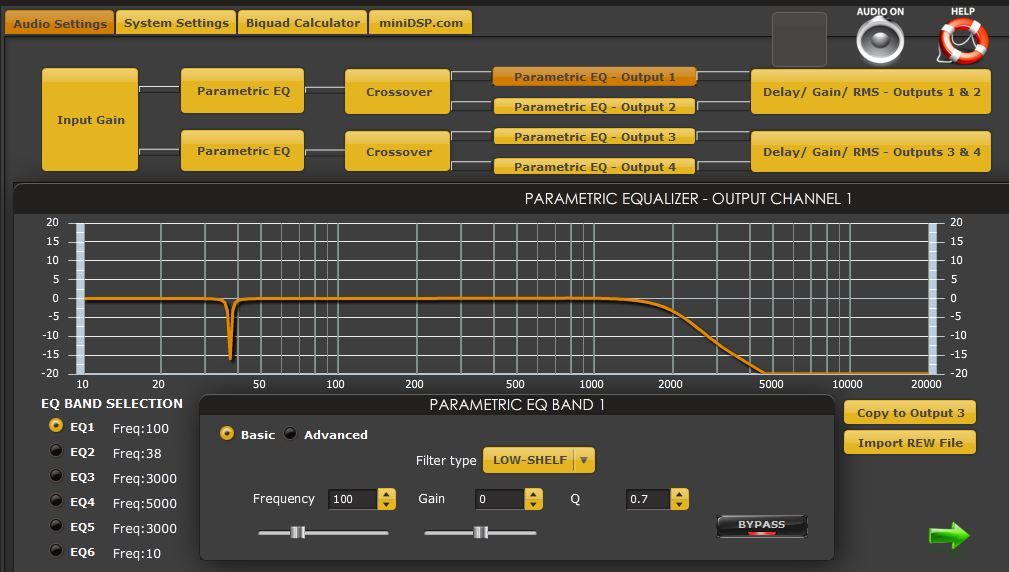
For the tweeter, without the low pass the adjust already taken care of anything below 900 hz. The Fs is addressed by a digital notch.
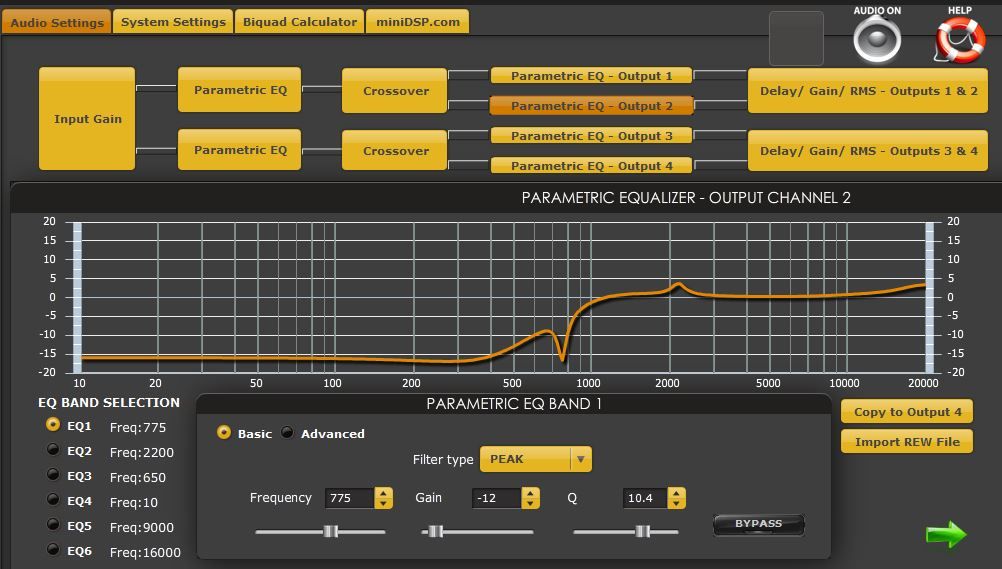
The systems work well at a crossover F at about 1400Hz, which is very low. but this is outside of the 1500-4000khz area which the human ears are very sensitive to on Amplitude and phase.
To further minimize the phase difference of the tweeters, a time delay for the tweeter is set at about 160us.
This is Texas Instrument analog calculations and opamp method to add time delay to the tweeter:
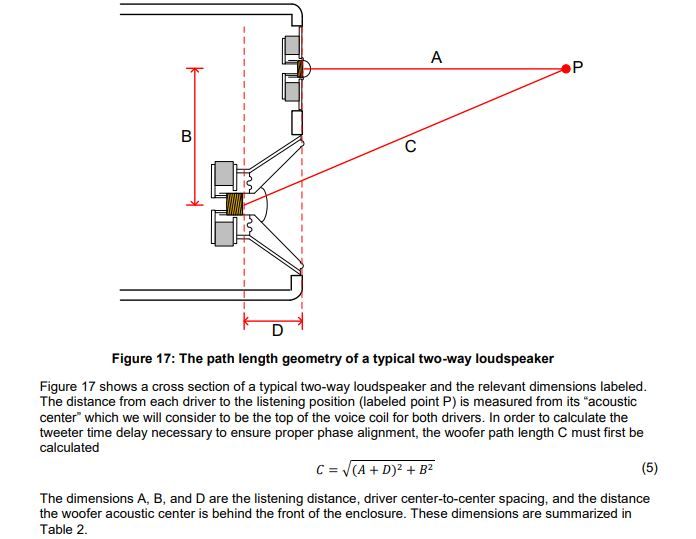
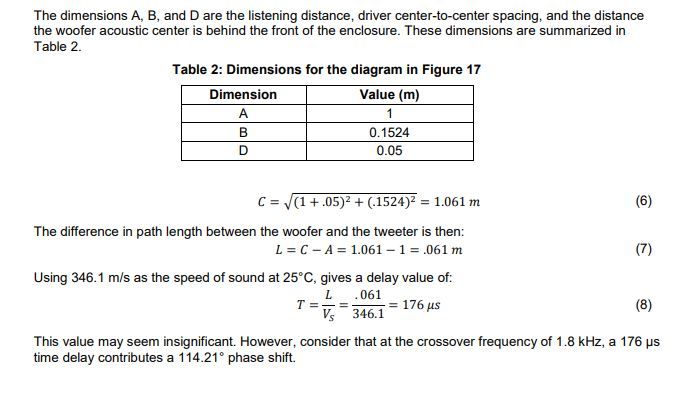
The final speakers have a very good imaging and transient. Without the passive coils or caps, the speaker has very little distortion and very fast transients.
The DSP provides infinite combinations for tuning.
Without using passive filters, the 3000hz cone break ups is addressed by parametric filters. Anything above 5000hz is shelved.

For the tweeter, without the low pass the adjust already taken care of anything below 900 hz. The Fs is addressed by a digital notch.

The systems work well at a crossover F at about 1400Hz, which is very low. but this is outside of the 1500-4000khz area which the human ears are very sensitive to on Amplitude and phase.
To further minimize the phase difference of the tweeters, a time delay for the tweeter is set at about 160us.
This is Texas Instrument analog calculations and opamp method to add time delay to the tweeter:


The final speakers have a very good imaging and transient. Without the passive coils or caps, the speaker has very little distortion and very fast transients.
The DSP provides infinite combinations for tuning.
Nice job! And these Dayton drivers are worth every penny
Thanks ! Indeed the speaker now sounds very good.
- Status
- Not open for further replies.
- Home
- Loudspeakers
- Multi-Way
- KEF 104aB rebuild with MiniDSP and Dayton drivers


